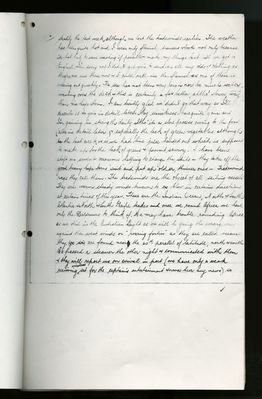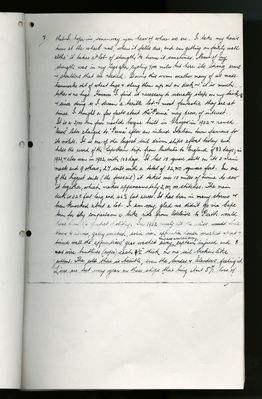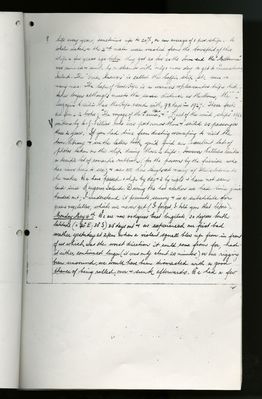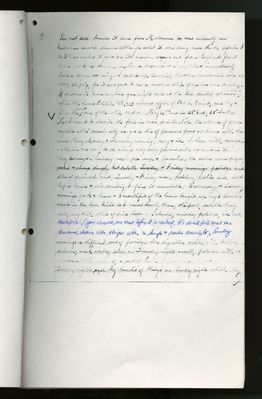Pages
Page 6
6
steadily the last week, although we lost the tradewinds earlier. The weather has been quite hot and I wear only flannel trousers & boots not only because its hot but to save washing if possible & make my things last till we get to England. I'm sorry now I didn't get you to send-on all my odds of clothing as they're no use there now & I could well use the flannel as one of these is wearing out quickly. The sea has not been very rough nor too much water washing over the deck & this is certainly a far better, altho' slower way than via Cape Horn. I am terribly glad we didn't go that way as I'll describe it to you in detail later. My seasickness has quite gone and I'm gaining in strength daily, altho' its a slow process owing to the food. (also in detail later) & especially the lack of green vegetables although in the last week or so we had lime juice handed out which is supposed to make up for the lack of greens & prevent scurvy. I have been aloft on several occasions helping to change the sails - they take off the good heavy Cape Horn "suit" and put up older, thinner ones - Tradewind rags they call them. The tradewinds are the object of all sailing vessels. They are warm steady winds known to blow in certain directions at certain times of the year. There are the Indian Ocean, North and South Atlantic & North and South Pacific trades, and once we round Africa we have only the Doldrums to think of. We may have trouble rounding Africa as we did in the Australian Bight as we will be going the wrong way against the west winds or "roaring forties" as they are called because they [crossed out] are found near the 40th parallel of latitude, north & south. We passed a steamer the other night & communicated with them & they will report us on arrival in port (we have only a weak recieving wireless set for the captain's entertainment & never hear any news) so
Page 7
7.
that I hope in some way you hear of where we are. I take my hour's turn at the wheel now, when it falls due, and am getting on fairly well altho' it takes a lot of strength to turn it sometimes. Most of my strength was in my legs after cycling 7,000 miles but here its strong arms & shoulders that are needed. During this warm weather many of us made hammocks out of wheat bags & slung them up out on deck & it is much better & no bugs. However I find it necessary to usually sleep on my back & since doing so I dream a terrible lot & most fantastic they are at times. I thought a few facts about the "Parma" may prove of interest. It is a 3,000 ton four masted barque built in Glasgow in 1902 & named "Arrow" later changed to "Parma" after an inland Italian town famous for its violets. It is one of the larges sail driven ships afloat today and holds the record of the Cape Horn trip from Australia to England of 83 days; in 1933, & also won in 1932 with 103 days. It has 18 square sails on its 3 main masts and 9 others; 27 sails with a total of 32,000 square feet. In one of the biggest sails (the foresail) it takes over 10 miles of twine to sew it together, which makes approximately 2,000,000 stitches. The main deck is 328 feet long and 46½ feet across. It has been in many storms & been knocked about a lot. I am very glad we didn't go via Cape Horn for by comparison, a bike ride from Adelaide to Perth would have been the perfect holiday. In 1932 nearly all the sails were blown to ribbons, galley wrecked, solid iron apprentice house wrecked & bent & twised & all the apprentices' gear washed away, compass washed away, captain injured and 8 new wire buntlines (ropes) each 1/2" thick on one sail broken like cotton. The cold there is terrible, even the Swedes and Alanders feeling it. Lives are lost every year on these ships there being about 5% loss of
Page 8
8
life every year, sometimes up to 20%, or an average of 1 per ship. A whole watch & the 2nd mate were washed from the bowsprit of this ship a few years ago before they got as far as the Horn and the "Melbourne" was rammed and sunk by a steamer with only 1 more day to get to Queenstown Ireland. The "Grace Harwar" is called the Coffin ship, she loses so many men. The Cape of Good Hope is a warmer and pleasanter trip but takes longer although much the same distance as the Horn; the Herzogin Cecilie has the Hope record with 98 days in 1927. These facts are from 2 books; "The voyage of the Parma 1932" and "Last of the wind ships" 1933, written by A. J. Villiers who was part owner then and sailed as passenger those 2 years. If you had time from dusting & sweeping to visit the town library & see the latter book, you'd find an excellent lot of photos taken on this ship during those 2 trips. However Villiers writes a terrific lot of romantic rubbish (for the person by the fireside who has never been to sea) and we all here laugh at many of the statements he makes. We have passed 1 ship by day and 3 by night and have not seen land since Kangaroo Island. During the hot weather we had lime juice handed out; I understand it prevents scurvy and is a substitute for green vegetables, which we never get. (I forgot, I told you that before).
Monday May 4th We are now 40 degrees East longitude, 30 degrees South latitude (=40 degrees E; 30 degrees S) 45 days out and we experienced our first bad weather yesterday at 2pm when a violent squall blew up from in front of us which was the worst direction it could come from for, had it either continued longer (it was only about 20 minutes) or our rigging been unsound, we would have been dismasted with a good chance of being rolled over and sunk afterwards. We had a few
Page 9
9
trade sails left to change but when the squall came they were there one minute and gone the next - torn to ribbons and blown away. The wind howled thru' the rigging, great waves washed over the deck and it got dark almost as night. Thank goodness it wasn't very cold nor happened at night. Both watches were called out & all hands from the captain down, except cook and steward, worked till dark cleaning up and replacing blown out sails and furling, or taking in, most of the others i.e. rolling them up and tying them to the yards. Whisky was handed round to all hands at dark but I didn't have any. My great regret is that I had no chance to take photos for I could have got some good ones but we were too busy working. I was aloft on several occasions helping to take in sails. Now it is fine warm weather again and mild moonlight nights with very little wind and we are sailing very slowly.
Thursday May 21st. We are now at 7° East long., 25° South lat, in the South. Atlantic Queen heading north west and 62 days from Port Victoria. We lost a lot of time in waiting for a good wind to get us around the Cape of Good Hope. The wind was mostly from the west and we just had to keep going north & south; then the wind dropped and we hardly moved at all & only did 30 miles one day. Then a wind, with some cold rough weather came from the south and we finally got around and into the S.E. Trades where we are going rather slowly about 4 knots (1 knot is a little more than a mile) an hour - 13 is very serious going, which we did rounding the Cape. The weather is gradually becoming finer & warmer but I'm still wearing socks, underpants and shirt. A passenger steamer passed us a week ago; came quite close & did a circle around us within half a mile. Its name started with "K" & I think it was Kanimbo (Kanimbla) but
Page 10
10
I'm not sure. However it came from Melbourne so was evidently an Australian coastal steamer although what it was doing near South Africa I don't know unless it was on its maiden voyage out from England for it looked new to me. Someone on board coo-eed & I replied & immediately heard a dozen coo-eeing. I called up Gardiner, the other Australian who was below, sleeping, for it was good to see a modern ship from our own country If you are in town anytime you might call at the Aus. coastal steamer office like Burns Phillip & Co, not overseas office of P&O or Orient, and try & find the correct name of the ship that on May 14th was in 23° East, 35° South. Now I meant to describe the food in more detail. Note the absence of green vegetable altho' occasionally we get a tin of preserved peas or beans with the meal. Every Monday & Thursday morning, curry & rice. I have milk & sugar on the rice & no curry as its always only curry powder with no meat in it.
Every Monday & Thursday noon, pea soup & pancakes, the latter never properly cooked & always doughy but eatable. Tuesday & Friday mornings porridge and slices of preserved meat; Tuesday & Friday noon, potatoes, pickles and salt beef so tough & evil smelling I find it uneatable. Wednesday & Saturday mornings pork & beans - 3 mouthfuls of the beans bought up my 2 previous meals in the Aus. Bight so I never touch them, the pork eatable being really very thick slices of fried bacon. Saturday midday potatoes, rice and stockfish, (you should see that before it is cooked, it's dried fish that the steward tears into strips with a knife & soaks overnight), Sunday mornings a different sort of porridge like digestive meal with tinned salmon; weak watery stew on Thursday nights mostly potatoes with no butter a little salmon; a sort of hash of preserved [??illegible too faint to read] Tuesday nights and big hunks of things on Sunday nights which they




